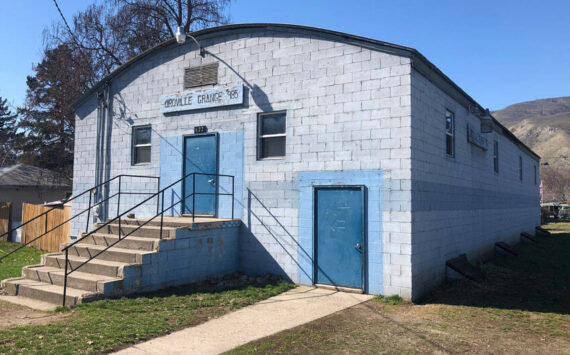Tonasket adopts resolution after Miller visit
TONASKET – Tonasket city council member Scott Olson had had questions about Okanogan County’s Emergency Management Plan that he wanted answered before the city signed off on a resolution that would include Tonasket as part of the plan.
That was in early September; Emergency Management’s Homeland Security Coordinator, Scott Miller, addressed Olson’s concerns at the Tuesday, Oct. 28, city council meeting to the point where it was Olson who himself moved to approve the resolution that declared the city’s adoption of the county’s multi-hazard mitigation plan, which included a terrorism and civil unrest mitigation plan.
Miller, who characterized himself as the “Darth Vader of Emergency Management,” said that the plan dealt with preparation, response, recovery and mitigation.
The recovery phase, which he said characterized the current status of last summer’s Carlton Complex firestorm disaster, he said could be spelled “FEMA and paperwork.”
“The key here is that every political jurisdiction … is required to have an emergency management function,” he said. “It’s law … You have two options. You can do it by yourself, or you can join everybody else… We have 13 cities in the county. We have a joint local organization.”
The cities pay in proportion to their population relative to that of the entire county. Tonasket, at 2.46 percent of the county population, paid $2,943 for the service last year; Oroville paid $5,256 and Omak paid nearly $15,000, he said.
Miller went through a list of about 25 state requirements that every political jurisdiction must meet to be legally prepared for a disaster.
“The good news is,” Miller said, “with a couple of exceptions, we do everything on this list for you. We are in compliance; you don’t have to do them yourself.”
Miller covered more specifics, and related them to how the county responded to the fire disaster, from which he himself is physically still recovering.
The city has been part of the joint local organization since 1997, Miller said.
“My concern,” Olson said, “has to do with mitigation. What happened during the fire … great, that’s good. Even in the (plan), it mentions a bunch of hazards we know about. What are we doing about them?”
“That’s up to you,” Miller said. “It comes down to, who wants to do something about these things, and is there money for it.”
“What I hear,” Olson said later, “you take care when there’s an emergency and you rush in. What I want is, you look at what could happen, let you know what can be done to mitigate it. I’m not hearing that being spoken at planning, told to the county commissioners. I just see the list of problems; what can we do?”
He cited, as examples, the vulnerability of the city the Janis Bridge and/or Fourth Street bridge be damaged.
“Is there a cache of food? Like if there were an earthquake that cut us off from our food supply?”
Miller said that the hurdles to apply for the kind of money that it would take to get funding for that kind of mitigation would involve competing with jurisdictions of all sizes nationwide.
“The system is necessarily intimidating,” Miller said. “Right now we have an advantage because of the fire. So for generators, or fixing the tanks by Pateros, they score all these as a competitive process, and they’ll give it to us because of the fire. But Richland (for example) could also apply for those funds.”
“My concern … I just wish there was more ‘plan’ to the plan,” Olson said. “Not so much how we’ll react. I want things to be in place and ready.”
Miller also addressed Olson’s concerns about the city ceding control during an emergency situation.
“First of all, you need to understand (Incident Command),” Miller said. “Part of that training for the IC, is seeing you’re not in trouble yet, but in two hours you’ll be in over your head. You get on the phone and call the county.
“We only come when we’re called. The county does not show up and say, ‘Get out of the way, we’re taking charge.’ We’ll come and ask how we can help.”
Miller added that, as part of the organization, the city would not be charged for response to a specific event.
He also said that, due to the magnitude of the 2014 disaster, funds had been depleted and the the rate would be going up to help replenish those funds.
Miller also asked if the city felt it could fulfill all of the state requirements and provide the Emergency Management services at the cost that the city pays for its membership in the coalition.
Near the end of the meeting, it was Olson who moved the council adopt the resolution, which was passed unanimously.
Dumpsters, Continued
The board received an assessment of the North Valley Hospital dumpster locations from City Superintendent Hugh Jensen and Permit Administrator Christian Johnson, which was also presented to hospital representative Noreen Olma at the meeting.
Johnson and Jensen will meet with NVH staff to work out an agreement that will include a franchise fee paid to the city for the use of some of the city sidewalk space.
“What’s been confusing to us,” Mayor Patrick Plumb said, “is that we don’t know exactly who we’re talking to on this from week to week. It would be really nice to have one person to discuss the overall issues with.”
Olma, attending the meeting on behalf of CEO Linda Michel, who was out of town on hospital business, apologized.
“I do apologize that you get me, but I want you to know that we’re taking this very seriously,” Olma said. “Now that we have this, I’ll take it back to the team and we can work on a plan.”
She added that she shocked at the what she felt was the feeling of ill will from the council toward the hospital that came out of the issue.
“That was our fault,” she said. “We haven’t done a good job of letting you the changes we’ve made in our senior leadership staff … I’m here to offer an olive branch and invite you to have a tour of the hospital, sit down and start the healing process… We want this relationship to work.”
“I’m sorry you felt ill will,” Olson said. “I don’t feel ill will; it’s our hospital, we’re proud of it and it’s one of the great things about the city. I wish you would use the word frustration; I think that’s more what the council is feeling, is frustrated.
“We have talked a number of times about this. I like the hospital but as being a good neighbor it’s left some to be desired.”
“Your candor and respect has been appreciated,” Plumb said.
“We want to be accountable,” Olma said. “We want to make this good.”
Park Traffic
A lengthy discussion was had regarding the traffic flow at Chief Tonasket Park, particularly in the area where the Tonasket Water Ranch splash park is being installed.
Tom Black, who has guided the engineering on the project, was on hand to propose a shift in the traffic near the water park to keep vehicles away from the picnic area portion of the park. There was some confusion over who on the council and in the committee overseeing the city’s limited role in the project was in favor of which route.
In the end, the council approved the proposal to allow the splash park to design the footprint in such a way as to prevent a roadway along the west side of the park, and “move” the road as long as it did not incur cost to the city.
Budget Hearing
A public budget workshop hearing primarily involved a debate regarding raising utility taxes. Plumb had proposed adding a tax to the water/sewer bill to begin putting money away for matching grant funds to apply toward funding the city’s stormwater drainage issues. There was also discussion about whether or not to add a tax to garbage pickup, and how to fully account with the public regarding where any tax increases would be dedicated.
“I think if we’re going to add a new tax,” Olson said, “we need to be pretty unanimous on that. That is a tough thing to be a split council on. If it’s not really important, we need to wait until it’s something where we can all be fully behind it.”
The council next meets on Wednesday, Nov. 12, a day later than usual due to Veterans Day.






